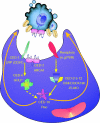The macrophage and the apoptotic cell: an innate immune interaction viewed simplistically?
- PMID: 15312130
- PMCID: PMC1782541
- DOI: 10.1111/j.1365-2567.2004.01959.x
The macrophage and the apoptotic cell: an innate immune interaction viewed simplistically?
Abstract
Macrophages play important roles in the clearance of dying and dead cells. Typically, and perhaps simplistically, they are viewed as the professional phagocytes of apoptotic cells. Clearance by macrophages of cells undergoing apoptosis is a non-phlogistic phenomenon which is often associated with actively anti-inflammatory phagocyte responses. By contrast, macrophage responses to necrotic cells, including secondarily necrotic cells derived from uncleared apoptotic cells, are perceived as proinflammatory. Indeed, persistence of apoptotic cells as a result of defective apoptotic-cell clearance has been found to be associated with the pathogenesis of autoimmune disease. Here we review the mechanisms by which macrophages interact with, and respond to, apoptotic cells. We suggest that macrophages are especially important in clearing cells at sites of histologically visible, high-rate apoptosis and that, otherwise, apoptotic cells are removed largely by non-macrophage neighbours. We challenge the view that necrotic cells, including persistent apoptotic cells are, of necessity, proinflammatory and immunostimulatory and suggest that, under appropriate circumstances, persistent apoptotic cells can provide a prolonged anti-inflammatory stimulus.
Figures





References
-
- Savill J, Fadok V. Corpse clearance defines the meaning of cell death. Nature. 2000;407:784–8. - PubMed
-
- Hengartner MO. Apoptosis: corralling the corpses. Cell. 2001;104:325–8. - PubMed
-
- Henson PM, Bratton DL, Fadok VA. The phosphatidylserine receptor: a crucial molecular switch? Nat Rev Mol Cell Biol. 2001;2:627–33. - PubMed
-
- Henson PM, Bratton DL, Fadok VA. Apoptotic cell removal. Curr Biol. 2001;11:R795–805. - PubMed
Publication types
MeSH terms
LinkOut - more resources
Full Text Sources
Other Literature Sources
